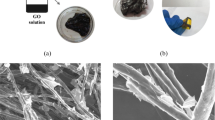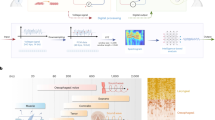Abstract
A wearable and high-precision sensor for sound signal acquisition and recognition was fabricated from thin films of specially designed graphene woven fabrics (GWFs). Upon being stretched, a high density of random cracks appears in the network, which decreases the current pathways, thereby increasing the resistance. Therefore, the film could act as a strain sensor on the human throat in order to measure one’s speech through muscle movement, regardless of whether or not a sound is produced. The ultra-high sensitivity allows for the realization of rapid and low-frequency speech sampling by extracting the signature characteristics of sound waves. In this study, representative signals of 26 English letters, typical Chinese characters and tones, and even phrases and sentences were tested, revealing obvious and characteristic changes in resistance. Furthermore, resistance changes of the graphene sensor responded perfectly with pre-recorded sounds. By combining artificial intelligence with digital signal processing, we expect that, in the future, this graphene sensor will be able to successfully negotiate complex acoustic systems and large quantities of audio data.

Similar content being viewed by others
References
Rabiner, L. R. A tutorial on hidden Markov models and selected applications in speech recognition. P. IEEE. 1989, 77, 257–286.
Sharma, N.; Gedeon, T. Objective measures, sensors and computational techniques for stress recognition and classification: A survey. Comput. Meth. Prog. Bio. 2012, 108, 1287–1301.
Shannon, R. V.; Zeng, F. G.; Kamath, V.; Wygonski, J.; Ekelid, M. Speech recognition with primarily temporal cues. Science 1995, 270, 303–304.
Shykhon, M. E.; Morgan, D. W.; Dutta, R.; Hines, E. L.; Gradner, J. W. Clinical evaluation of the electronic nose in the diagnosis of ear, nose and throat infection: A preliminary study. J. Laryngol. Otol. 2004, 118, 706–709.
Porwancher, R.; Sheth, A.; Remphrey, S.; Taylor, E.; Hinkle, C.; Zervos, M. Epidemiological study of hospital-acquired infection with vancomycin-resistant enterococcus faccium: Possible transmission by an electronic ear-probe thermometer. Cont. Hosp. Ep. 1997, 18, 771–773
Hammock, M. L.; Chortos, A.; Tee, B. C. K.; Tok, J. B. H.; Bao Z. N. 25th anniversary article: The evolution of electronic skin (E-skin): A brief history, design considerations, and recent progress. Adv. Mater. 2013, 25, 5997–6037.
Wang, X. W.; Gu, Y.; Xiong, Z. P.; Cui, Z.; Zhang, T. Silk-molded flexible, ultrasensitive, and highly stable electronic skin for monitoring human physiological signals. Adv. Mater. 2014, 26, 1336–1342.
Wang, Y.; Wang, L.; Yang, T. T.; Li, X.; Zang, X. B.; Zhu, M.; Wang, K. L.; Wu, D. H.; Zhu, H. W. Wearable and highly sensitive graphene strain sensors for human motion monitoring. Adv. Funct. Mater. 2014, 24, 4666–4670.
Kim, D. H.; Lu, N. S.; Ma, R.; Kim, Y. S.; Kim, R. H.; Wang, S. D.; Wu, J.; Won, S. M.; Tao, H.; Islam, A. et al. Epidermal electronics. Science 2011, 333, 838–843.
Xu, S.; Zhang, Y. H.; Jia, L.; Mathwson, K. E.; Jang, K. I.; Kim, J.; Fu, H. R.; Huang, X.; Chava, P.; Wang, R. H. et al. Soft microfluidic assemblies of sensors, circuits, and radios for the skin. Science 2014, 344, 70–74.
Son, D.; Lee, J.; Qiao, S. T.; Ghaffari R.; Kim, J.; Lee, J. E.; Song, C.; Kim, S. J.; Lee, D. J.; Jun, S. W. et al. Multifunctional wearable devices for diagnosis and therapy of movement disorders. Nat. Nanotecnol. 2014, 9, 397–404.
Gong, S.; Schwalb, W.; Wang, Y. W.; Chen, Y.; Tang, Y.; Si, J.; Shirinzadeh, B.; Cheng, W. L. A wearable and highly sensitive pressure sensor with ultrathin gold nanowires. Nat. Commun. DOI: 10.1038/ncomms4132.
Sokolov, A. N.; Tee, B. C. K.; Bettinger, C. J.; Tok, J. B. H.; Bao, Z. N. Chemical and engineering approaches to enable organic field-effect transistors for electronic skin applications. Acc. Chem. Res. 2012, 45, 361–371.
Meital, S. B.; Hossam, H. Flexible sensors based on nanoparticles. ACS Nano. 2013, 7, 8366–8378.
Sun, D. M.; Liu, C.; Ren, W. C.; Cheng, H. M. A revies of carbon nanotube- and graphene-based flexible thin-film transistors. Small 2013, 9, 1188–1205.
Rolnick, H. Tension coefficient of resistance of matals. Phys. Rev. 1930, 36, 506–512.
Yamada, T.; Hayamizu, Y.; Yamamoto, Y.; Yomogida, Y.; Izadi-Najafabadi, A.; Futaba, D. N.; Hata, K. A stretchable carbon nanotube strain sensor for human-motion detection. Nat. Nanotechnol. 2011, 6, 296–301.
Frank; Russel, A.; Pierce, H. F.; Eric, C. Electric resistance strain gauges. U.S. Patent 2, 2429087, Oct. 14, 1947.
Rasmussen, P. A.; Thaysen, J.; Hansen, O.; Eriksen, S. C.; Bisen, A. Optimised cantilever biosensor with piezoresistive read-out. Ultramicroscopy 2003, 97, 371–376.
Cao, J.; Wang, Q.; Dai, H. J. Electromechanical properties of metallic, quasimetallic, and semiconducting carbon nanotubes under stretching. Phys. Rev. Lett. 2003, 90, 157601.
Zhou, J.; Gu, Y. D.; Fei, P.; Mai, W. J.; Gao, Y. F.; Yang, R. S.; Bao, G.; Wang, Z. L. Flexible piezotronic strain sensor. Nano. Lett. 2008, 8, 3035–3040.
Li, X.; Sun, P. Z.; Fan, L. L.; Zhu, M.; Wang, K. L.; Zhong, M. L.; Wei, J. Q.; Wu, D. H.; Cheng, Y.; Zhu H. W. Multifunctional graphene woven fabrics. Sci. Rep. 2012, 2, 395.
Li, X.; Zhang, R. J.; Yu, W. J.; Wang, K. L.; Wei, J. Q.; Wu, D. H.; Cao, A. Y.; Li, Z. H.; Cheng, Y.; Zheng, Q. S. et al. Stretchable and highly sensitive graphene-on-polymer strain sensors. Sci. Rep. 2012, 2, 870.
Carpi, F.; Gallone, G.; Galantini, F.; De Rossi, D. Silicone-poly(hexylthiophene) blends as elastomers with enhanced electromechanical transduction properties. Adv. Funct. Mater. 2008, 18, 235–241.
Mi, Y. L.; Chan Y. N.; Trau, D.; Huang P. B.; Chen, E. Micromolding of PDMS scaffolds and microwells for tissue culture and cell patterning: A new method of microfabrication by the self-assembled micropatterns of diblock copolymer micelles. Polymer 2006, 47, 5124–5130.
Li, X. S.; Cai, W. W.; An, J.; Kim, S.; Nah, J.; Yang, D. X.; Piner, R.; Velamakannni, A.; Jung, I.; Tutuc, E. et al. Large-area synthesis of high-quality and uniform graphene film on copper foils. Science 2009, 324, 1312–1314.
Balaban, N. Q.; Schwarz, U. S.; Riveline, D.; Goichberg, P.; Tzur, G.; Sabanay, I.; Mahalu, D.; Safran, S.; Bershadsky, A.; Addadi, L. et al. Force and focal adhesion assembly: A close relationship studied using elastic micropatterned substrates. Nature Cell Biol. 2001, 3, 466–472.
Lee, M.; Chen, C. Y.; Wang, S.; Cha, S. N.; Park, Y. J.; Kim, J. M.; Chou, L. J.; Wang. Z. L. A hybrid piezoelectric structure for wearable nanogenerators. Adv. Mater. 2012, 24, 1759–1764.
Xiao, X.; Yuan, L. Y.; Zhong, J. W.; Ding, T. P.; Liu, Y.; Cai, Z. X.; Rong, Y. G.; Han, H. Y.; Zhou, J.; Wang Z. L. High-strain sensors based on ZeO nanowire/polystyrene hybridized flexible films. Adv. Mater. 2011, 23, 5440–5444.
Luo, S. D.; Liu, T. SWCNT/graphite nanoplatelet hybrid thin films for self-temperature-compensated, highly sensitive, and extensible piezoresistive sensors. Adv. Mater. 2013, 25, 5650–5657.
Zhu, B. W.; Niu, Z. Q.; Wang, H.; Leow, W. R.; Wang, H.; Li, Y. G.; Zheng, L. Y.; Wei, J.; Huo, F. W.; Chen X. D. Microstructured graphene arrays for highly sensitive flexible tactile sensors. Small 2014, 10, 3625–3631.
Author information
Authors and Affiliations
Corresponding author
Additional information
These authors contributed equally to this work.
Electronic supplementary material
Rights and permissions
About this article
Cite this article
Wang, Y., Yang, T., Lao, J. et al. Ultra-sensitive graphene strain sensor for sound signal acquisition and recognition. Nano Res. 8, 1627–1636 (2015). https://doi.org/10.1007/s12274-014-0652-3
Received:
Revised:
Accepted:
Published:
Issue Date:
DOI: https://doi.org/10.1007/s12274-014-0652-3




